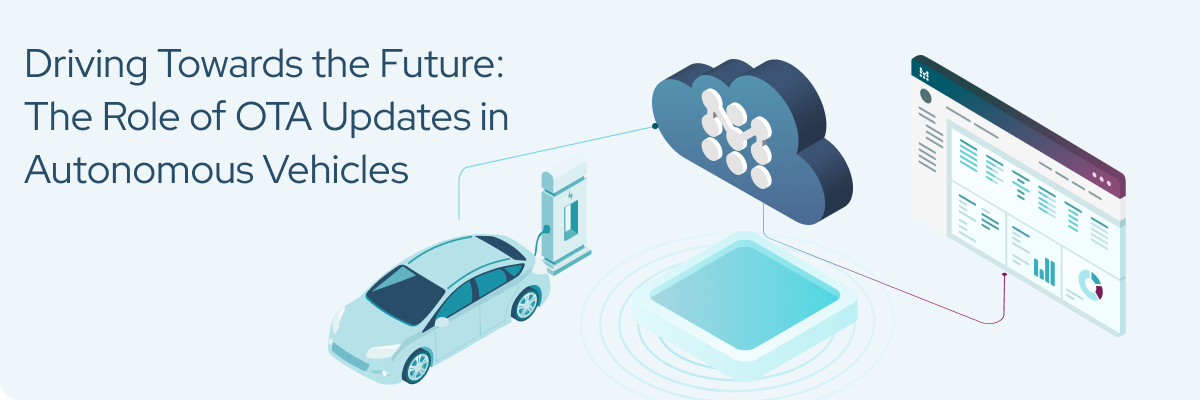
With the rise of autonomous vehicles, the automotive industry is experiencing a monumental transformation. As stated on Forbes, “Embarking on this industrial revolution via technology, today’s largest enterprises are and must undergo a cultural revolution. They must embrace software and technology as the linchpin for not just their business’ success but survival.”
As self-driving cars become a reality, one crucial element is propelling this revolution forward: over-the-air (OTA) updates. These updates are not only revolutionizing vehicle maintenance but also playing a vital role in enhancing safety, optimizing performance, and shaping the future of autonomous driving. OTA updates are playing a crucial role in the development and deployment of autonomous vehicles, ensuring vehicle software remains up-to-date and competitive with the latest advancements.
Enhancing safety, performance, and real-time adaptability with OTA updates
The safety of autonomous vehicles is of utmost importance, and OTA updates offer a remarkable advantage in this regard.
By deploying software enhancements remotely, manufacturers can elevate safety features, sensor systems, and collision avoidance algorithms. This means that self-driving cars can receive real-time updates, enabling them to adapt to evolving road conditions and potential dangers. For instance, an OTA update could enhance a self-driving car's ability to identify and respond to pedestrians, cyclists, or unexpected obstacles on the road.
Further, OTA updates empower manufacturers to swiftly address emerging challenges that autonomous vehicles may encounter in dynamic environments, such as road construction, weather fluctuations, or unusual driving conditions. With OTA updates, self-driving cars can access the most up-to-date maps, traffic data, and algorithm improvements in real-time, ensuring vehicles make safer and more informed decisions on the road. This agility in responding to challenges and changes not only enhances safety and performance but also fosters consumer trust in autonomous driving technology and the companies behind them.
Elevating the customer experience with limitless improvements
OTA updates go beyond enhancing safety and performance; they also contribute significantly to the overall customer experience. With regular updates, automakers can enhance the user interface, infotainment systems, and personalized driving preferences of autonomous vehicles. Manufacturers can release new services, innovations, and features – with greater agility and speed. In turn, customers can enjoy a more intuitive and personalized driving experience tailored to their specific needs and preferences.
For example, automakers can update the user interface to be more user-friendly and intuitive, making it easier for customers to navigate through various features and settings. They can also improve the infotainment systems by adding new entertainment options, integrating popular apps, and enhancing connectivity features. Additionally, OTA updates allow for the customization of driving preferences, enabling customers to personalize settings such as seat position, climate control, and driving modes.
By enhancing the user interface, infotainment systems, and personalized driving preferences, automakers can create a seamless and user-friendly OTA update process that not only grants customers access to the latest features and improvements but also enhances their satisfaction and loyalty towards the brand. This unmatched level of personalization and convenience ensures that customers feel valued and connected to their autonomous vehicles, fostering a strong relationship with the brand and increasing their overall satisfaction.
Strengthening cybersecurity and regulatory compliance for autonomous vehicles
While there are many positive aspects to autonomous vehicles, it is crucial to acknowledge the potential risks posed by hackers and cyber adversaries targeting self-driving cars. Regulations like ISO/SAE 21434 and UNECE R155/R156 aim to safeguard vehicles within a cyber-physical landscape. Adopting cybersecurity best practices becomes critical. ISO/SAE 21434 and UNECE R155/R156 establish a solid security foundation through building efficient, robust, and secure OTA updates.
The introduction of over-the-air (OTA) updates provides manufacturers with a powerful tool to enhance the security of self-driving cars. By remotely deploying security patches and updates, vulnerabilities can be swiftly addressed, reducing the risk of cyber attacks. Automakers can effectively safeguard autonomous vehicles by incorporating encryption, authentication, and secure communication protocols through OTA updates, ensuring greater safety.
Additionally, OTA updates are vital for regulatory compliance and adherence to strict safety standards for autonomous vehicles. This flexibility allows automakers to address safety concerns and meet evolving regulatory requirements promptly. By utilizing OTA updates, self-driving cars can stay up-to-date with the latest safety standards. The combination of robust cybersecurity measures and regulatory compliance through OTA updates paves the way for a future of autonomous driving that is safe and cyber secure.
The future of driving requires OTA updates
OTA updates are propelling the automotive industry forward and towards a future dominated by smart and autonomous vehicles – revolutionizing transportation as we know it. With the ability to continuously enhance safety features, optimize performance, and swiftly adapt to emerging challenges, OTA updates are driving the development and deployment of safer and more efficient self-driving cars. These updates play a pivotal role in safeguarding autonomous vehicles from cyber threats and ensuring compliance with regulatory standards. As automakers embrace OTA updates to improve the customer experience and enhance vehicle performance, the road to a fully autonomous and secure future becomes clearer than ever before.
Recent articles
Failed lifecycle management is unacceptable in FDA and MDR compliance
The struggle to reach global markets for medical device manufacturers: The importance of international compliance
The differences between the US FDA’s device approval process and the EU’s medical device regulation (MDR): An essential dual-compliance framework for global manufacturers
Learn why leading companies choose Mender
Discover how Mender empowers both you and your customers with secure and reliable over-the-air updates for IoT devices. Focus on your product, and benefit from specialized OTA expertise and best practices.



